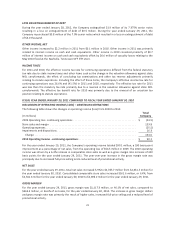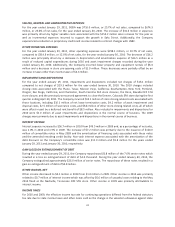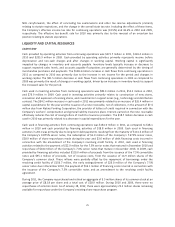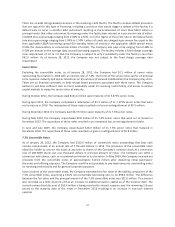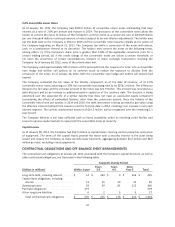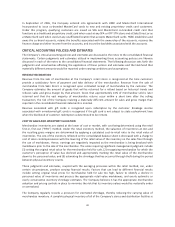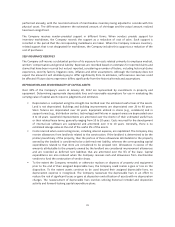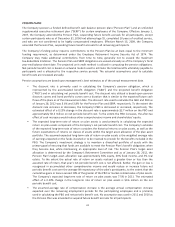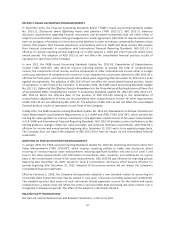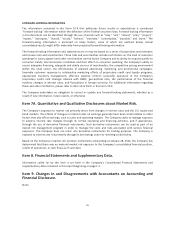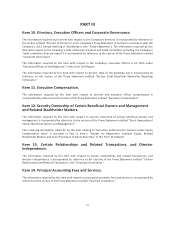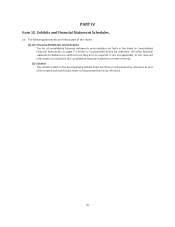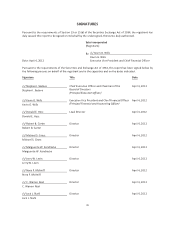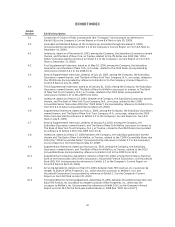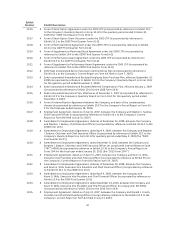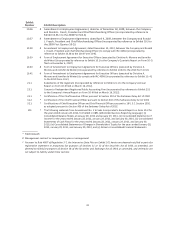Saks Fifth Avenue 2011 Annual Report Download - page 35
Download and view the complete annual report
Please find page 35 of the 2011 Saks Fifth Avenue annual report below. You can navigate through the pages in the report by either clicking on the pages listed below, or by using the keyword search tool below to find specific information within the annual report.PENSION PLANS
The Company sponsors a funded defined-benefit cash balance pension plan (“Pension Plan”) and an unfunded
supplemental executive retirement plan (“SERP”) for certain employees of the Company. Effective January 1,
2007, the Company amended the Pension Plan, suspending future benefit accruals for all participants, except
certain participants who as of December 31, 2006 had attained age 55, completed 10 years of credited service,
and who are not considered to be highly compensated employees. Effective March 13, 2009, the Company
amended the Pension Plan, suspending future benefit accruals for all remaining participants.
The Company’s funding policy requires contributions to the Pension Plan be at least equal to the minimum
funding requirement, as determined under the Employee Retirement Income Security Act of 1974. The
Company may make additional contributions from time to time, generally not to exceed the maximum
tax-deductible limitation. The Pension Plan and SERP obligations are valued annually as of the Company’s fiscal
year-end balance sheet date. The projected unit credit method is utilized in computing the pension obligations.
Net periodic benefit cost is based on actuarial models used to estimate the total benefits ultimately payable to
participants and is allocated to the respective service periods. The actuarial assumptions used to calculate
benefit costs are reviewed annually.
Pension assumptions are based upon management’s best estimates as of the annual measurement date.
▪The discount rate is primarily used in calculating the Company’s pension obligation, which is
represented by the accumulated benefit obligation (“ABO”) and the projected benefit obligation
(“PBO”) and in calculating net periodic benefit cost. The discount rate utilized is based upon pension
discount curves and bond portfolio curves over a duration that is similar to the expected future cash
flows of the plans as of the measurement date. The discount rate used to calculate the ABO and PBO as
of January 28, 2012 was 3.6% and 3.8% for the Pension Plan and SERP, respectively. To the extent the
discount rate increases or decreases, the Company’s PBO is decreased or increased, respectively. The
estimated effect of a 0.25% change in the discount rate is approximately $2.7 million on the PBO and
approximately $0.2 million on net periodic benefit cost. To the extent the PBO increases, the after-tax
effect of such increases would reduce other comprehensive income and shareholders’ equity.
▪The expected long-term rate of return on plan assets is used primarily in calculating the expected
return on plan assets component of the Company’s net periodic benefit cost. The Company’s estimate
of the expected long-term rate of return considers the historical returns on plan assets, as well as the
future expectations of returns on classes of assets within the target asset allocation of the plan asset
portfolio. The assumed expected long-term rate of return on plan assets is the weighted average rate
of earnings expected on the funds invested or to be invested to provide for the benefits included in the
PBO. The Company’s investment strategy is to maintain a diversified portfolio of assets with the
primary goal of ensuring that funds are available to meet the Pension Plan’s benefit obligations when
they become due, while maintaining an appropriate level of risk. The Pension Plan’s target asset
allocation is determined by the Company’s Retirement Committee and as of January 28, 2012, the
Pension Plan’s target asset allocation was approximately 35% equity, 60% fixed income, and 5% real
estate. To the extent the actual rate of return on assets realized is greater than or less than the
assumed rate of return, that year’s net periodic benefit cost is not affected. Rather, the gain or loss is
recognized in accumulated other comprehensive income and would reduce or increase future net
periodic benefit cost over the average life expectancy of the plan’s participants, to the extent that the
cumulative gains or losses exceed 10% of the greater of the PBO or market-related value of plan assets.
The Company’s expected long-term rate of return on plan assets was 7.5% in 2011. The estimated
effect of a 0.50% change in the long-term rate of return on plan assets is $0.6 million on the net
periodic benefit cost.
▪The assumed average rate of compensation increase is the average annual compensation increase
expected over the remaining employment periods for the participating employees and is primarily
used in calculating the PBO and net periodic benefit cost. No assumption was used in 2011 and 2010 as
the Pension Plan was amended to suspend future benefit accruals for all participants.
33


